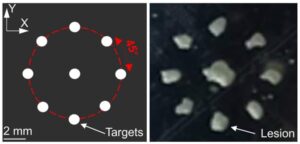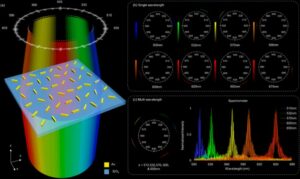
Researchers in China have shown how measurements of strain, temperature and vibration can be made simultaneously on a single optical fibre. This could be used to create a fibre-based system to to monitor a number of different physical parameters in infrastructure such as buildings, bridges and railways.
The work was done by Xinyu Fan at Shanghai Jiao Tong University and colleagues and the their system uses two successive light pulses to measure three different types of light scattering in real time.
Distributed fibre-optic sensing (DFOS) is used for monitoring large, complex infrastructures. Optical fibres are attached to parts of the infrastructure and are subject to high-intensity light pulses. Some of this light will interact with the fibre and be scattered back to the source, where it is detected.
Single end
This backscattered light contains information about the state of the fibre including its temperature, strain, and mechanical vibrations. This information is extracted in real time with the help of specialized algorithms. A key benefit of this “single end” approach is that it can monitor the entire length of an optical fibre, which can be kilometres in length, using equipment installed at one end of the fibre.
However, current DFOS sensors tend to only measure a single parameter at a time, which limits their use. This limitation arises because DFOS involves three different types of scattering and each type needs to be monitored with a different approach – and combining the three had been a costly and complicated endeavour.
One scattering effect used in DFOS is Rayleigh backscattering, which occurs when the incident light scatters from microscopic density fluctuations in the fibre. This scattering arises because the refractive index of the fibre is related to its density. By monitoring the interference between this backscattered light and a reference beam, researchers can monitor mechanical vibrations in the fibre with extreme accuracy.
Quantized vibrations
Another relevant effect is Brillouin scattering, which occurs when incident photons interact with acoustic phonons. The latter are quantized, long-wavelength vibrations in the fibre. This results in a shift (up or down) in the energy of scattered photons and is detected as a change in the wavelength of some of the detected light. Brillouin scattering provides information about strain and temperature in the fibre.
The third interaction is Raman scattering, which is similar to Brillouin scattering but involves interactions between photons and shorter-wavelength optical phonons in the fibre. This interaction is used to monitor the fibre’s temperature alone, without being affected by strain.

Undersea optical fibre monitors seismic activity and ocean waves
Now, Fan and colleagues have developed a hybrid DFOS system that monitors all three of these scattering processes at once. This is done by firing two successive light pulses into the fibre and analysing the light that comes back. The first pulse is optimized to measure Rayleigh backscattering, while the second is optimized for measuring Brillouin scattering. Raman scattering data can be extracted independently from measurements on both pulses.
The team was able to achieve the simultaneous measurement of strain, temperature, and vibration using a single fibre that was about 9 km in length.
With the early success of their new approach to DFOS, the team now hopes its technology could soon be adapted to monitor complex, large-scale infrastructures in real time.
Such systems could be a great help in the development of “smart cities”, in which devices, systems, and sensors are seamlessly interconnected to monitor the patterns, trends, and needs that emerge in complex urban landscapes. In turn, this could help to boost the efficiency and sustainability of these communities, while improving quality of life for the many people who call them home.
The research is described in Light: Advanced Manufacturing
- SEO Powered Content & PR Distribution. Get Amplified Today.
- PlatoData.Network Vertical Generative Ai. Empower Yourself. Access Here.
- PlatoAiStream. Web3 Intelligence. Knowledge Amplified. Access Here.
- PlatoESG. Automotive / EVs, Carbon, CleanTech, Energy, Environment, Solar, Waste Management. Access Here.
- BlockOffsets. Modernizing Environmental Offset Ownership. Access Here.
- Source: https://physicsworld.com/a/fibre-optic-sensing-system-measures-strain-temperature-and-vibration/
- :is
- :where
- $UP
- 2023
- a
- Able
- About
- accuracy
- Achieve
- activity
- advanced
- algorithms
- All
- alone
- an
- Analysing
- and
- approach
- ARE
- AS
- At
- back
- BE
- Beam
- because
- been
- being
- benefit
- between
- boost
- both
- bridges
- but
- by
- cable
- call
- CAN
- change
- China
- colleagues
- combining
- comes
- Communities
- complex
- complicated
- contains
- costly
- could
- create
- Current
- data
- described
- detected
- developed
- Development
- Devices
- different
- done
- down
- each
- Early
- effect
- efficiency
- emerge
- end
- energy
- Entire
- equipment
- extreme
- fan
- firing
- First
- fluctuations
- For
- from
- great
- had
- Have
- help
- Home
- hopes
- How
- HTTPS
- Hybrid
- image
- improving
- in
- incident
- Including
- independently
- index
- information
- Infrastructure
- infrastructures
- installed
- interact
- interaction
- interactions
- interconnected
- Interference
- into
- issue
- IT
- ITS
- jpg
- Key
- large
- large-scale
- Length
- Life
- light
- limitation
- limits
- made
- many
- many people
- max-width
- measure
- measurement
- measurements
- measures
- measuring
- mechanical
- Monitor
- monitored
- monitoring
- monitors
- needs
- New
- now
- number
- ocean
- of
- on
- once
- ONE
- only
- optimized
- or
- parameter
- parameters
- parts
- patterns
- People
- Photons
- physical
- Physics
- Physics World
- plato
- Plato Data Intelligence
- PlatoData
- processes
- properties
- provides
- pulse
- quality
- railways
- real
- real-time
- related
- relevant
- research
- researchers
- Results
- scattered
- seamlessly
- Second
- sensors
- several
- shanghai
- shift
- shown
- similar
- simultaneously
- single
- some
- soon
- Source
- specialized
- State
- subject
- success
- such
- Sustainability
- system
- Systems
- team
- Technology
- that
- The
- The Source
- The State
- their
- Them
- These
- Third
- this
- three
- thumbnail
- time
- to
- Trends
- true
- TURN
- two
- type
- types
- university
- urban
- use
- used
- uses
- using
- was
- when
- which
- while
- WHO
- will
- with
- without
- Work
- world
- zephyrnet













